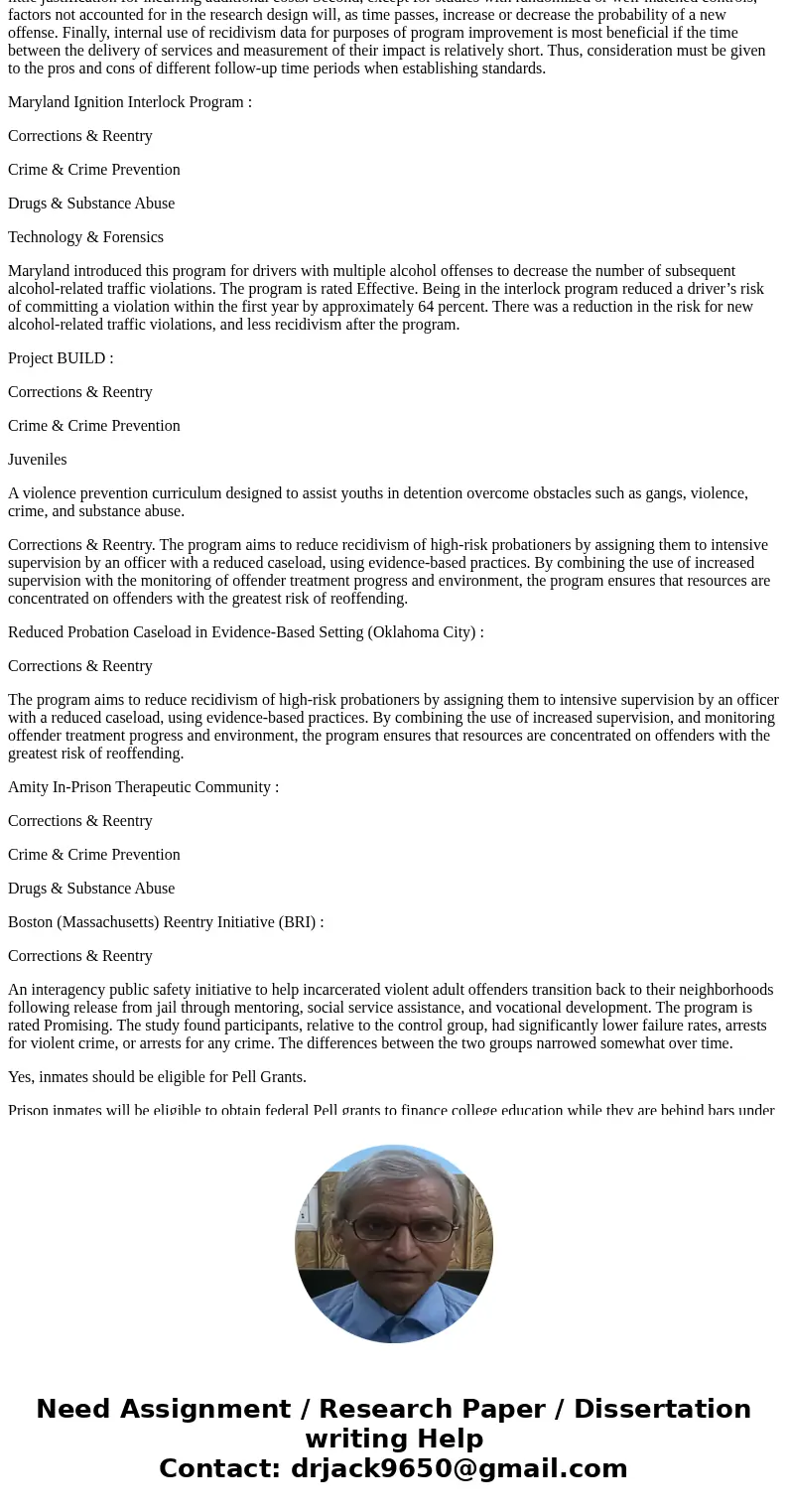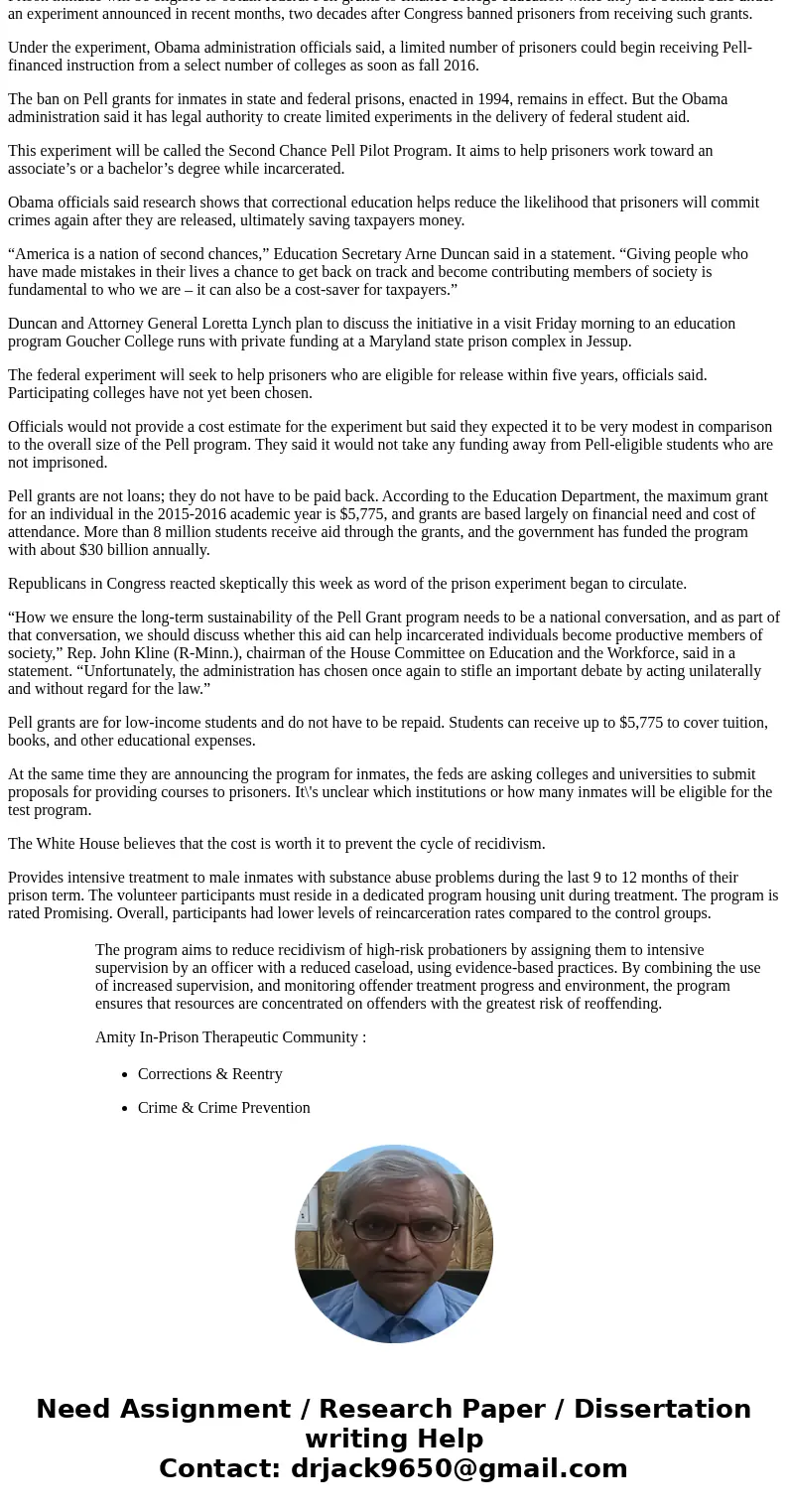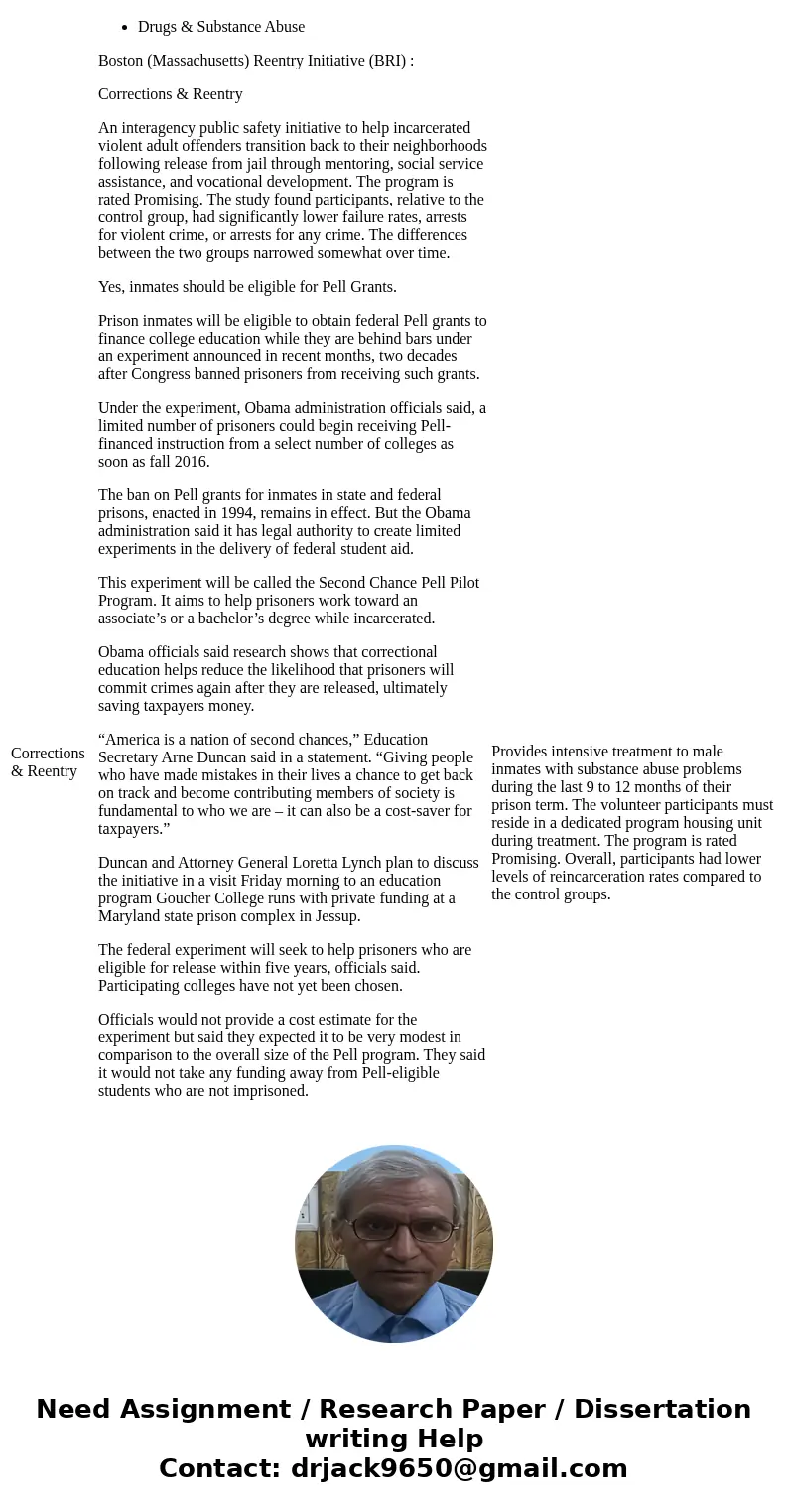Discuss whether or not you feel these programs are effective
Discuss whether or not you feel these programs are effective in preventing recidivism. Do you think inmates should be eligible for Pell Grants? Why, or why not?
Solution
Recidivism is the act of relapsing into a problem or criminal behavior during or after receiving sanctions, or while undergoing an intervention due to a previous behavior or crime. In criminal justice settings, recidivism is often measured by criminal acts that result in rearrest, reconviction, or return to prison. Yes, these programs are effective in preventing recidivism. Recidivism data have been reported in terms of a variety of measures, including re-arrest, re-adjudication, and re-incarceration. As a result, policy makers are often unable to make sense of seemingly disparate findings or draw meaningful conclusions about program or system performance. Common definitions and indicators are necessary to clearly communicate the meaning of outcome study results, to unambiguously describe the methods used to obtain research findings, to enable replication of research designs, to make possible comparisons across studies and regions, and to facilitate our understanding of program or system effectiveness.
By definition, recidivism comprises two elements: 1) the commission of an offense, 2) by an individual already known to have committed at least one other offense (Blumstein & Larson, 1971). To have a truly operable definition, one must clarify and qualify both parts.
Regarding the first half of the definition, one must ask: What constitutes “commission of an offense?” Does the definition include status offenses? Would parole violations fall under the definition? One might assume that the phrase “commission of an offense” refers to a criminal act and thus excludes status offenses and parole violations. Consistency requires that the phrase “commission of an offense” be defined explicitly.
For the second half of the definition, one must ask: Who is considered to be “an individual already known to have committed at least one other offense?” In the case of a juvenile, must the juvenile have been found guilty of an offense? If the juvenile had been arrested but diverted prior to adjudication, is she included in this definition? A policy maker might argue that diversion does not imply innocence; in fact, it implies or requires admission of guilt. Thus, if a youth who was previously diverted comes before the court on a subsequent offense, is that not recidivism? Evaluators must agree on uniform answers to these questions or their findings will be difficult to interpret or compare.
Measuring Recidivism
The terms “define” and “measure” are often confused by non-researchers. Whereas “define” refers to the meaning of a word—in this case, recidivism—“measure” refers to a method of systematically determining its extent or degree within a given sample. In program evaluations, the measures are the types of data used to determine recidivism levels. These data types include, among others, self-reports of re-offending, arrest records, and court records of adjudication and disposition.
The distinctions among these measures are important, as their use will generate vastly disparate results. Snyder and Sickmund (2006) found that when measuring recidivism as re-arrests, there is an average; however, when measuring recidivism as re-incarceration, they find only a 12% recidivism rate (see also Mears & Travis, 2004). In general, we can expect measures derived from actions occurring later in the case processing system to produce lower recidivism rates. The shrinkage stems from the decisions of officials to remove (dismiss or divert) some cases at each decision point, allowing only the remaining cases to continue to the next stage in the process.
A program evaluation’s follow-up methods can also dramatically affect the level of recidivism researchers detect. For example, researchers may measure recidivism from different starting points, such as when juveniles are released from institutions to aftercare or when their cases are terminated by the court (Barnoski, 1997; Maltz, 1984). Researchers also may employ follow-up periods of different durations (longer periods of follow-up are likely to increase the proportion of youths found to reoffend). Furthermore, instead of using the same follow-up duration for each case, researchers may terminate follow-up on a particular date, thus limiting the time of follow-up for some cases.
Another common oversight is the omission of adult offenses. If a juvenile transitions to the adult system (as a result of age or the case being waived), evaluators will not detect his or her re-offenses if data are restricted to juvenile corrections records. This omission would result in an undercount of recidivism. The major obstacle to obtaining these data is, of course, access. Political and technical barriers need to be removed if recidivism studies are to follow cases for a reasonable period of time. Our review of the juvenile justice program evaluation literature (see below) showed a preference for a follow-up of two years.
Obviously, researchers may choose not to follow cases for as long as several years, in part because data collection costs increase with time. As long as the follow-up period is sufficient to capture a large proportion of new offenses, there is little justification for incurring additional costs. Second, except for studies with randomized or well-matched controls, factors not accounted for in the research design will, as time passes, increase or decrease the probability of a new offense. Finally, internal use of recidivism data for purposes of program improvement is most beneficial if the time between the delivery of services and measurement of their impact is relatively short. Thus, consideration must be given to the pros and cons of different follow-up time periods when establishing standards.
Maryland Ignition Interlock Program :
Corrections & Reentry
Crime & Crime Prevention
Drugs & Substance Abuse
Technology & Forensics
Maryland introduced this program for drivers with multiple alcohol offenses to decrease the number of subsequent alcohol-related traffic violations. The program is rated Effective. Being in the interlock program reduced a driver’s risk of committing a violation within the first year by approximately 64 percent. There was a reduction in the risk for new alcohol-related traffic violations, and less recidivism after the program.
Project BUILD :
Corrections & Reentry
Crime & Crime Prevention
Juveniles
A violence prevention curriculum designed to assist youths in detention overcome obstacles such as gangs, violence, crime, and substance abuse.
Corrections & Reentry. The program aims to reduce recidivism of high-risk probationers by assigning them to intensive supervision by an officer with a reduced caseload, using evidence-based practices. By combining the use of increased supervision with the monitoring of offender treatment progress and environment, the program ensures that resources are concentrated on offenders with the greatest risk of reoffending.
Reduced Probation Caseload in Evidence-Based Setting (Oklahoma City) :
Corrections & Reentry
The program aims to reduce recidivism of high-risk probationers by assigning them to intensive supervision by an officer with a reduced caseload, using evidence-based practices. By combining the use of increased supervision, and monitoring offender treatment progress and environment, the program ensures that resources are concentrated on offenders with the greatest risk of reoffending.
Amity In-Prison Therapeutic Community :
Corrections & Reentry
Crime & Crime Prevention
Drugs & Substance Abuse
Boston (Massachusetts) Reentry Initiative (BRI) :
Corrections & Reentry
An interagency public safety initiative to help incarcerated violent adult offenders transition back to their neighborhoods following release from jail through mentoring, social service assistance, and vocational development. The program is rated Promising. The study found participants, relative to the control group, had significantly lower failure rates, arrests for violent crime, or arrests for any crime. The differences between the two groups narrowed somewhat over time.
Yes, inmates should be eligible for Pell Grants.
Prison inmates will be eligible to obtain federal Pell grants to finance college education while they are behind bars under an experiment announced in recent months, two decades after Congress banned prisoners from receiving such grants.
Under the experiment, Obama administration officials said, a limited number of prisoners could begin receiving Pell-financed instruction from a select number of colleges as soon as fall 2016.
The ban on Pell grants for inmates in state and federal prisons, enacted in 1994, remains in effect. But the Obama administration said it has legal authority to create limited experiments in the delivery of federal student aid.
This experiment will be called the Second Chance Pell Pilot Program. It aims to help prisoners work toward an associate’s or a bachelor’s degree while incarcerated.
Obama officials said research shows that correctional education helps reduce the likelihood that prisoners will commit crimes again after they are released, ultimately saving taxpayers money.
“America is a nation of second chances,” Education Secretary Arne Duncan said in a statement. “Giving people who have made mistakes in their lives a chance to get back on track and become contributing members of society is fundamental to who we are – it can also be a cost-saver for taxpayers.”
Duncan and Attorney General Loretta Lynch plan to discuss the initiative in a visit Friday morning to an education program Goucher College runs with private funding at a Maryland state prison complex in Jessup.
The federal experiment will seek to help prisoners who are eligible for release within five years, officials said. Participating colleges have not yet been chosen.
Officials would not provide a cost estimate for the experiment but said they expected it to be very modest in comparison to the overall size of the Pell program. They said it would not take any funding away from Pell-eligible students who are not imprisoned.
Pell grants are not loans; they do not have to be paid back. According to the Education Department, the maximum grant for an individual in the 2015-2016 academic year is $5,775, and grants are based largely on financial need and cost of attendance. More than 8 million students receive aid through the grants, and the government has funded the program with about $30 billion annually.
Republicans in Congress reacted skeptically this week as word of the prison experiment began to circulate.
“How we ensure the long-term sustainability of the Pell Grant program needs to be a national conversation, and as part of that conversation, we should discuss whether this aid can help incarcerated individuals become productive members of society,” Rep. John Kline (R-Minn.), chairman of the House Committee on Education and the Workforce, said in a statement. “Unfortunately, the administration has chosen once again to stifle an important debate by acting unilaterally and without regard for the law.”
Pell grants are for low-income students and do not have to be repaid. Students can receive up to $5,775 to cover tuition, books, and other educational expenses.
At the same time they are announcing the program for inmates, the feds are asking colleges and universities to submit proposals for providing courses to prisoners. It\'s unclear which institutions or how many inmates will be eligible for the test program.
The White House believes that the cost is worth it to prevent the cycle of recidivism.
Provides intensive treatment to male inmates with substance abuse problems during the last 9 to 12 months of their prison term. The volunteer participants must reside in a dedicated program housing unit during treatment. The program is rated Promising. Overall, participants had lower levels of reincarceration rates compared to the control groups.
| Corrections & Reentry | The program aims to reduce recidivism of high-risk probationers by assigning them to intensive supervision by an officer with a reduced caseload, using evidence-based practices. By combining the use of increased supervision, and monitoring offender treatment progress and environment, the program ensures that resources are concentrated on offenders with the greatest risk of reoffending. Amity In-Prison Therapeutic Community :
|





 Homework Sourse
Homework Sourse